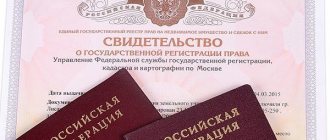ST 170 of the Criminal Code of the Russian Federation.
Registration of obviously illegal transactions with real estate, deliberate distortion of information from the state real estate cadastre and (or) the Unified State Register of Rights to Real Estate and Transactions with It, as well as understatement of the cadastral value of real estate, if these acts were committed out of selfish or other personal interest by an official using his official position, -
shall be punishable by a fine in the amount of two hundred thousand to five hundred thousand rubles, or in the amount of the wages or other income of the convicted person for a period of one to three years, or by deprivation of the right to hold certain positions or engage in certain activities for a term of up to three years, or by compulsory labor for a term up to three hundred and sixty hours with deprivation of the right to hold certain positions or engage in certain activities for a period of up to three years.
Commentary to Art. 170 Criminal Code
1. The objective side of the crime is characterized by the following alternative actions: a) registration of obviously illegal transactions with real estate; b) deliberate distortion of information from the state real estate cadastre and (or) the Unified State Register of Rights to Real Estate and Transactions with It; c) underestimation of the cadastral value of real estate.
2. A transaction made in violation of the provisions of the Civil Code of the Russian Federation and the requirements of other legislation is illegal (for example, transactions with lands that are excluded from circulation on the basis of the law or are limited in circulation if the transaction results in a violation of established restrictions).
3. The State Real Estate Cadastre, being a state information resource, is a systematic collection of information about registered real estate. The state real estate cadastre is maintained on paper and (or) electronic media by Rosreestr.
Distortion of registration data of the state real estate cadastre is expressed in the creation of falsified registration data using false entries or partial forgeries. For example, the following information about the unique characteristics of the property may be falsified: type of property (land plot, etc.); cadastral number and date of entry of this cadastral number into the state real estate cadastre; category of land to which the land plot is assigned; permitted use; description of the location of the boundaries of the land plot, etc.
The State Real Estate Cadastre on electronic media is part of a unified federal information system that unites the State Real Estate Cadastre on electronic media and the Unified State Register of Rights to Real Estate and Transactions with It on electronic media.
The Unified State Register of Rights contains information about existing and terminated rights to real estate objects, data about these objects and information about right holders.
Rights to real estate and transactions with it are subject to state registration in the Unified State Register of Rights.
An integral part of the Unified State Register of Rights are files of title documents opened for each property, and document books containing data on documents accepted for registration.
4. Understating the cadastral value of real estate is the entry into the state real estate cadastre of deliberately false information regarding the cadastral value of real estate.
5. The subject of this crime can only be an official, for example, a tax authority, Rosreestr.
Commentary on Article 170 of the Civil Code of the Russian Federation
1. In Russian legislation, imaginary and feigned transactions are traditionally identified as a special type of invalid transactions. At the same time, the legislator’s approach to their essence has remained unchanged for many years (cf. Art. 170 with Art. 34 - 35 of the Civil Code of 1922 and Art. 53 of the Civil Code of 1964).
The recognition of imaginary and feigned transactions as void is based on the fact that such transactions have no basis, since the parties do not at all strive to achieve the legal result that should arise from this transaction. By making an imaginary or feigned transaction, the parties only want to create the appearance of the emergence, change or termination of civil rights and obligations that arise from this transaction. Thus, imaginary and feigned transactions do not meet the characteristics of a civil transaction (Article 153 of the Civil Code).
In this quality, imaginary and feigned transactions are no different from each other. However, if sham transactions are concluded only in order to create a false impression among third parties about the intentions of the parties to the transaction, then sham transactions are concluded not just for show, but to cover up another transaction that the parties actually intend to complete. Therefore, in a pretend transaction, it is customary to distinguish between two transactions: a) the actual pretend transaction, made for show (covering transaction); b) the transaction actually carried out by the parties (covered transaction). Moreover, the first transaction, as having no basis, is always invalid (void), and the validity of the second transaction is assessed from the standpoint of the rules of law applicable to it.
2. Imaginary and feigned transactions refer to transactions with defects of will, since the will of the parties, put in proper form, diverges from their inner will. As is known, transactions involving vices of will are mostly voidable. The legislator declares imaginary and feigned transactions void, i.e. transactions, the invalidity of which does not need to be confirmed by a court. Meanwhile, the discrepancy between the will expressed by the parties to the transaction and their true will is far from an obvious fact that requires convincing evidence.
Since most often, with the help of imaginary and feigned transactions, participants in civil transactions try to achieve illegal goals, in particular, to circumvent prohibitions or restrictions established by law, the main purpose of the Civil Code rules on imaginary and feigned transactions is to establish a certain barrier to such actions.
3. The greatest difficulties arise when proving the nullity of sham transactions. The signs by which one can conclude that a transaction concluded between the parties is fraudulent are hardly amenable to exhaustive generalized expression. Nevertheless, based on doctrine and judicial practice, the following characteristic features of sham transactions can be identified:
a) any sham transaction is characterized primarily by the fact that the parties seek to disguise their true intentions by making it, i.e. cover up the deal they really have in mind. On the contrary, if the parties clearly and unambiguously state their true intentions in the transaction(s) they are entering into, then there is no reason whatsoever to classify this transaction as a sham, since it does not cover anything. Another thing is that, in execution of a completed transaction, the same parties or with the involvement of other parties may conclude some other transaction or even a series of transactions, the execution of which (which) may be dependent on the execution of the first transaction. This circumstance in itself does not give any reason to question the validity of concluded transactions, if they do not contradict current legislation;
b) since a sham (covering) transaction is made only for show, one of the external indicators of its sham is the failure of the parties to perform those actions that are provided for by this transaction. On the contrary, if the parties have fulfilled the rights and obligations arising from the transaction, then such a transaction cannot be recognized as feigned, even if they initially did not intend to fulfill it;
c) as already noted, most often sham transactions are made for illegal purposes, i.e. in order to circumvent the prohibitions and restrictions established by law, infringe on the rights and interests protected by law of other persons, obtain unjustified advantages, etc. Therefore, if the legal result that the parties actually sought does not contain anything illegal, this, as a rule, speaks in favor of the fact that the transaction is not a sham.
However, this sign should not be made absolute, since sometimes in practice completely legal transactions are covered up, which for some reason the parties want to hide from others. However, this is relatively rare compared to covering up illegal transactions;
d) sham transactions are characterized, as a rule, by the coincidence of the parties in the covering and covered transactions. This is explained by the fact that the parties still strive to achieve a certain legal result precisely in their relationships with each other.
However, this is also not a mandatory sign of a sham transaction. It is usually present when only two parties are involved in transactions, and the covering and covered transactions themselves are “one-way” operations. The simplest example in this regard is the use of a sham deed of gift to cover up a purchase and sale agreement that is actually between the same parties.
In practice, there are situations when, in order to cover up a transaction that the parties actually want to make, they make a chain of interconnected transactions for the sake of appearance, including those with the participation of third parties. However, even in this case, when a whole chain of interconnected transactions turns out to be a sham (covering), it is necessary that, relatively speaking, the initial and final sides of the transactions coincide;
e) it should be taken into account that some transactions, in particular transactions of an intermediary nature, by their very nature lead to a discrepancy between the external and internal relations of the parties and, accordingly, give rise to the appearance of sham transactions. For example, this occurs in the case of acquiring property from a third party, but not directly, but through a commission agent.
4. The fraudulent nature of the transaction can be proven using all evidence permitted by procedural law. In particular, in relation to a covert transaction, the Judicial Collegium for Civil Cases of the Supreme Court of the RSFSR explained that “sham transactions can be confirmed by all available means of evidence, including testimony. The civil procedure legislation does not provide for any exceptions on this issue” (Bulletin of the Supreme Court. 1991. No. 11).
In practice, the issue of the sham of a transaction is resolved in each specific case, taking into account all factual circumstances, based on the above provisions. If the interested party fails to prove the sham of the transaction, one should proceed from the presumption that the expression of will expressed by the parties correctly reflects their internal will, and therefore come to a conclusion about the validity of the transaction that was made by the parties.
Second commentary to Art. 170 of the Criminal Code of the Russian Federation
1. The article combines three independent crimes, all of which relate to real estate:
1) registration of obviously illegal transactions with real estate;
2) deliberate distortion of information from the state real estate cadastre and (or) the Unified State Register of Rights to Real Estate and Transactions with It;
3) underestimation of the cadastral value of real estate.
2. In Art. 130 of the Civil Code defines: immovable things include: land plots, subsoil plots and everything that is firmly connected to the land, that is, objects whose movement without disproportionate damage to their purpose is impossible, including buildings, structures, unfinished construction objects; aircraft, sea vessels and inland navigation vessels subject to state registration; other property.
The right of ownership and other real rights to immovable things, restrictions on these rights, their emergence, transfer and termination are subject to state registration in the unified state register by the bodies carrying out state registration of rights to real estate and transactions with it.
3. State registration of rights to real estate is a legal act of recognition and confirmation of the emergence, change, transition, termination of the right of a certain person to real estate or restriction of such a right and encumbrance of real estate. State registration of rights is carried out by making a record in the Unified State Register of Real Estate of the right to real estate, information about which is included in the Unified State Register of Real Estate. The right of ownership and other proprietary rights to real estate and transactions with it are subject to state registration in accordance with Articles 130, 131, 132, 1331 and 164 of the Civil Code, as well as those arising, including on the basis of an agreement, or an act of a government body, or an act local government body, restrictions on rights and encumbrances of real estate, in particular easement, mortgage, trust management, rent, rental of residential premises (Article 1 of the Federal Law of July 13, 2015 No. 218-FZ “On State Registration of Real Estate”, hereinafter referred to as the Federal Law of July 13, 2015 .2015).
4. The objective side of the first crime is the registration of obviously illegal transactions with real estate.
Transactions are illegal if they contradict current civil and (or) other, for example, land legislation.
5. The subject of the second crime under Art. 170 of the Criminal Code, the following information is provided:
1) state real estate cadastre and (or)
2) The Unified State Register of Rights to Real Estate and Transactions with It.
6. The crime encroaches on the registration of real estate, including cadastral registration.
State cadastral registration of real estate is the entry into the Unified State Register of Real Estate of information about land plots, buildings, structures, premises, parking spaces, objects of unfinished construction, unified real estate complexes, and in cases established by federal law, and about other objects , which are firmly connected to the land, confirming the existence of such a property with characteristics that make it possible to define it as an individually defined thing, or the termination of its existence, as well as other information about real estate provided by law (Article 1 of the Federal Law of July 13, 2015).
7. The objective side of distortion of cadastral and (or) register information is the introduction of false entries into the documents of the State Real Estate Cadastre or partial falsification of true accounting data, which can be expressed in erasures, additions, erasing entries and making new ones, etc.
8. The elements of registration of obviously illegal transactions with real estate and distortion of information from the State Real Estate Cadastre are special cases of official forgery. Articles 170 and 292 of the Criminal Code compete here as special and general norms. According to the qualification rules, a special standard must be applied, i.e. Art. 170 CC.
9. The subject of the third crime under Art. 170 of the Criminal Code, the cadastral value of real estate objects is used, i.e. the value established as a result of the state cadastral valuation or as a result of the consideration of disputes about the results of determining the cadastral value, or determined in the cases provided for in Art. 24.19 Federal Law of July 29, 1998 No. 135-FZ “On valuation activities in the Russian Federation” (Article 3 of this law).
10. The objective side of understating the cadastral value of real estate is an illegal reduction.
11. A crime in all its manifestations is considered completed from the moment the act specified in the disposition of the article is committed.
12. The subjective side is characterized by direct intent.
A mandatory sign of the subjective side is selfish or other personal interest.
13. Subject: an official using his official position.
Judicial practice under Article 170 of the Criminal Code of the Russian Federation
Ruling of the Constitutional Court of the Russian Federation dated October 24, 2019 N 2725-O
1. By the decision of the court, left unchanged by the court of appeal, the claim of citizen S.V. was partially satisfied. Posokhov to the Ministry of Finance of the Russian Federation for compensation for moral damages for illegal prosecution under paragraph “b” of part three of Article 188 of the Criminal Code of the Russian Federation, illegal use of criminal procedural coercive measures, violation of the inviolability of home and private life, as well as the right to a good name . The same decision rejected similar demands related to criminal prosecution under Part One of Article 170 of the Criminal Code of the RSFSR and Part One of Article 194 of the Criminal Code of the Russian Federation, since the proceedings in the relevant criminal case were terminated by the court on January 31, 2002 due to the expiration of the statute of limitations criminal prosecution. In the transfer of cassation complaints S.V. Posokhov's request for these court decisions to be considered in a court session by the cassation court was refused.
Another commentary on Article 170 of the Civil Code of the Russian Federation
1. A transaction that is not aimed at creating corresponding legal consequences is imaginary; it does not meet the characteristics of a transaction established by Art. 153 of the Civil Code, and is recognized by the Civil Code as void. In the legislation, some imaginary transactions are called fictitious (Article 73 of the LC).
2. An imaginary transaction is such regardless of the form of its conclusion and the actual fulfillment by the parties of their obligations. Consequences of an imaginary transaction in Art. 170 are not defined, and the general rules on the consequences of invalidity of a transaction established by Art. 167 (see commentary to it).
3. A sham transaction is also not aimed at the emergence of legal consequences arising from it, it covers up the other will of the participants in the transaction and, due to this, is recognized by the Civil Code as void. In these cases, the rules about the transaction that the participants actually had in mind are applied (for example, if instead of buying and selling property, the parties formalized its donation, the rules about the purchase and sale agreement are subject to application).
4. The imaginary or feigned nature of a transaction can be proven using all the evidence allowed in civil proceedings. In relation to a covert transaction, the Judicial Collegium for Civil Cases of the Supreme Court of the RSFSR explained that “sham transactions can be confirmed by all available means of evidence, incl. testimony. The civil procedure legislation does not provide for any exceptions on this issue” (Bulletin of the Supreme Court of the RSFSR, 1991, No. 11, p. 2).
5. Imaginary and feigned transactions often cover transactions with a purpose that is contrary to the foundations of law and order and morality (Article 169 of the Civil Code). In these cases, the consequences of a confiscation nature provided for in Art. 169 Civil Code.




